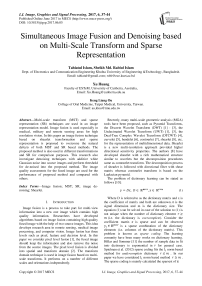Simultaneous Image Fusion and Denoising based on Multi-Scale Transform and Sparse Representation
Автор: Tahiatul Islam, Sheikh Md. Rabiul Islam, Xu Huang, Keng Liang Ou
Журнал: International Journal of Image, Graphics and Signal Processing(IJIGSP) @ijigsp
Статья в выпуске: 6 vol.9, 2017 года.
Бесплатный доступ
Multi-scale transform (MST) and sparse representation (SR) techniques are used in an image representation model. Image fusion is used especially in medical, military and remote sensing areas for high resolution vision. In this paper an image fusion technique based on shearlet transformation and sparse representation is proposed to overcome the natural defects of both MST and SR based methods. The proposed method is also used in different transformations and SR for comparison purposes. This research also investigate denoising techniques with additive white Gaussian noise into source images and perform threshold for de-noised into the proposed method. The image quality assessments for the fused image are used for the performance of proposed method and compared with others.
Image fusion, MST, SR, image de-noising, Shearlet
Короткий адрес: https://sciup.org/15014196
IDR: 15014196
Текст научной статьи Simultaneous Image Fusion and Denoising based on Multi-Scale Transform and Sparse Representation
Published Online June 2017 in MECS DOI: 10.5815/ijigsp.2017.06.05
Image fusion is a process to take part for multi-view information into a new one image which contains high quality information. Researchers have developed algorithms based on image fusion containing high quality fused image with the help of two source images. This idea develops research area in remote sensing, medical image processing, and computer vision. Image fusion has three levels such as pixel, feature and decision level. In this paper we consider pixel level fusion [1], the fused image should keep the information and also remove the noise from the source images. The pixel level fusion is divided into spatial and transform domain [2]. The transform domain technique is used in image fusion based on multiscale transforms. It performs on a number of different scales and orientations independently.
Recently, many multi-scale geometric analysis (MGA) tools have been proposed, such as Pyramid Transforms, the Discrete Wavelet Transform (DWT) [1] - [3], the Undecimated Wavelet Transform (UWT) [1], [3], the Dual-Tree Complex Wavelet Transform (DTCWT) [4], curvelet [5], bandelet [6], contourlet [7], shearlet [8], etc. for the representation of multidimensional data. Shearlet is a new multi-resolution approach provided higher directional sensitivity properties. The authors [8] have developed shearlet with a rich mathematical structure similar to wavelets but the decomposition procedures same as contourlet transform. The decomposition process of shearlet is followed with directional filter with shear matrix whereas contourlet transform is based on the Laplacian pyramid.
The problem of dictionary learning can be stated as follows [10]:
y = Dx,DE ®тхг, x e ^rxn (1)
Where D is referred to as the dictionary matrix and x is the coefficient of matrix and both are unknown. n is the signal dimension and m is the dictionary size. The equation (1) can be solved in case of the solution to (1) is not unique when the number of dictionary element r > m (i.e. the dictionary is overcomplete). Consider the coefficient matrix x is sparse and can be observed У/ e ^mxr is a sparse combination of the dictionary elements (i.e. columns of the dictionary matrix). This problem is known as sparse coding. The learning comunity have been many works on dictionary learning. Hillar and Sommer [11] the number of sample data in fit into dictionary is exponential in r for general case. Spielman et al. (2012) sparse coding fits the 11 norm based method for undercomplete dictionary r < m . In our paper we have considered 11 norm based method r >m . The sparse coding is mainly calculated the sparsest of x which contains the fewest nonzero elements. This coding method has shown stability and efficient of algorithm Yaghoobi et al. [10] .Yang and Li et al. [11] had used sliding window technique into Sparse coding and focused on fusion process more robust than noise and registration.
A hybrid model of image fusion using MST and SR based method is proposed here where the framework is compared with different MGA method and the result is analyzed. The main purpose of this paper is to use that hybrid model for shearlet transform and sparse representation and to use de-noising method to remove any noise subjected to source images.
This paper is organized firstly for giving the theoretical description of shearlet transform and sparse modeling then the framework for image fusion and comparison of the proposed method with existing method and finally the conclusion of it.
1 (0) (O = Щ^) = Ф1«1)& (|)
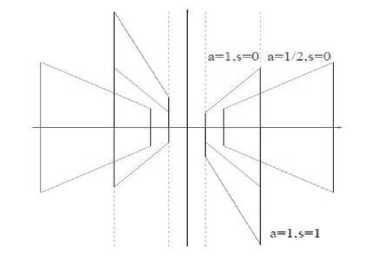
Fig.1. Frequency support of the shearlets p j,i,k for different values of a and s [8].
Where 1 1 e C ” (K) is a wavelet, and supp 1 1
II. Shearlets
The theory of composite wavelets provides an effective approach for combining geometry and multi-scale analysis by taking advantage of the classical theory of affine systems. In dimension n=2, the affine systems with composite dilations are defined as follows [8]
aasow = {i j^k Cx) = MetA^ p(S l A j x -k):j, I e
Z, к e z} (2)
Where p e l2 (k2) is called composite wavelet. A,S are both 2 X 2 invertible matrix, and | det S| = 1, the elements of this system are called composite wavelet if AAs(p) forms a tight frame for l2(^2)^l< f,PLlik> I2 = llfll2
j,l,k
Let A denote the parabolic scaling matrix and S denote the shear matrix. For each a > 0 and s e R,
A = (i >=(0 S)
The size of frequency support of the shearlet is illustrated in Fig. 1 for some particular values of aand s. In [8], consider a = 4 , s = 1 ; where A = A0 is the anisotropic dilation matrix and S = S0 is the shear matrix, which are given by
A o = (0 0).S o = (0 1)
Fo V ^ = (ll)e R 2 , ^ * 0, let ф (0) (О be given by
|- 1 ,;т| u [-^Л] ; 1 2 e C” № and supp p 2
2 16 16 2
[-1, 1] .
[-
1 1 ] 2
2,2-*
.
This implies 1 (0) e C ” (K) and
In addition, we assume that
1 (0)
c
c
c
Zj20l11 (2-2M|2 = 1,H > 1/8
and for V j > 0
Z2i--127|p2(2jw-l)|2 = 1,|w|<1
Equation (3) and (4) imply that
£ Ц |i 0 Цл . S.)r ^ Ц |1m2 2 U|2 |p 2 (2j|-l)|2 = 1
j>0 ,=-2i j>0 ,=-2i
For any (fvf 2 ) e ^ 0 , where D 0 ={(f 1 ,f 2 ) e R 2 :|f 1 | > 1 ,|f2| < 1}, the functions {p (0) (fAo j S( - 1 )} form a tiling of D0. This is illustrated in Fig. 2(a). This property described above implies that the collection.
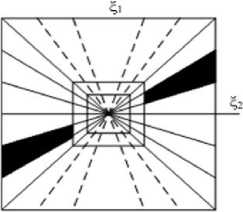
(a)
Fig.2. (a) The tiling of the frequency by the shearlets. (b) The size of the frequency support of a shearlet ^ j-l-k [8].
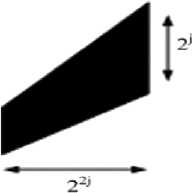
(b)
{
1
j
,
l
,
k
(0)
(x)=22
p
(0)
(S
0
A
j
0
X-k): j>0,-2
j
is a Parseval frame for 12 = (D0)v{f £ £2(T2) : supp f £ D0} based on the support of t and t2 can easily be observe that the functions t; k have frequency support, slфpф T С {(£,Ур£( -22 v22 4|U 2 2 4,22 jjk , |2 |<2 }
That is, each element $. z k is supported on a pair of trapezoids, of approximate size 22j×2j, oriented along lines of slope l2-j as shown in Figure 2 (b).
Similarly we can construct a Parseval frame for L2 (D 1 ) v, where D 1 is the vertical cone,
D1={«1.b)eR2:|ti>V8|||<1}
Let Л = [0 4] and S = (} 1]
and t1 ) be given by
t(1)(f) = ^С1)(|1Л2) = ^(М^ (I1)
where t and t2 are defined above. Then the collection [8]
t7(1)fc = 2~ t(1)(S1^x - fc): j> 0,-2j < 2j,fc £ X2
Is a Parseval frame for £ 2 (D 1 ) v . Finally let t £ C 0°° (T 2 ) be chosen to satisfy
G(f) = |t(f)|2 + Rj + Pj = 1
Where
»t = I2l ■ • (■ j>0 l=-2i
Pj = S7-aoS2=-1v| tC1)(fS1X^)|2^D1(f) = 1
for f £ T 2
where %D denotes the indicator function of the set D. This implies that t с [- 1 , 1 ] with |t| = 1 for f с [- 1 , 1 ] and the set {t(x - fc): fc £ X 2 } is a Parseval frame for £2 ([- ^<1] ) . It is observed that, by the properties of t(d),d = 0;1 , it follows that the function
G(f) = (I1,|2) is continuous and regular along the lines 12 = ±1 (as well as for any other f £ T 2 ) [8].
-
III. Basic Theory of Signal Sparse Representaion (SR)
SR is based on linear combination of a prototype signal from dictionary [12]. The following notation [12], considered f £ T ” be n real valued samples signal. The sparse representation theory the dictionary is formed on D £ T nxm , which contains m prototype signals. This dictionary D which determines the signal is sparse. In the dictionary D, there exists a linear combination of prototype signal and it shows Vx £ f, 3s £ RT such that x ~ Ds, where s is sparse coefficients of x in D. It usually assumes that m > n, implying that the dictionary D is redundant and it follows Restricted Isometric Property (RIP) [12].This property solves the problem of reconstruction of signal with optimization problem to find the smallest possible number of nonzero components of s:
mins ||s||0 subject to | |Ds - x|| < £ (5)
This is called 1 0 -norm and ||s||0 denoting the number of nonzero coefficients in sparses. This is an NP-hard problem. This problem can only be solved by systematically testing based on combinations of columns D.This problem is solved by greedy algorithms such as the basis pursuits (BP), matching pursuit (MP) and the orthogonal MP (OMP) algorithms [13].
-
IV. Sparse Repsentation for Image Fusion
The sparse representation (SR) handles an image in globally. But it cannot handle image fusion because it depends on the local information of source images. The source images are divided into small patches with fixed dictionary D to solve this problem. In addition, a sliding window technique and shift invariant are also important to image fusion for the sparse representation.
We consider that a source image I is divided into j small patches by size n x n as shown in Figure 3. It can be represented into lexicographically orders as a vector u . Then, V7 can express as u = ZT=1Sj(t)dt (6)
where j is the number of image patches and dt is an atoms/prototype from D and D =
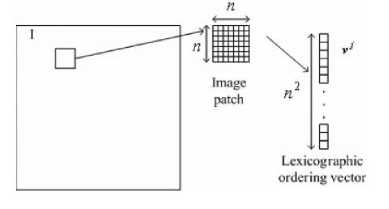
Fig.3. A source image patches and its lexicographic ordering vector.
The image patches of I are now rebuild into one matrix v. Then, v can be expressed as
|
S 1 (1) |
S2(1) . |
■ S>(1)1 |
||||
|
v = [d1 ... |
.dt... |
.dr] |
S 1 (2) |
S2(2) . |
■ S > (2) |
(7) |
|
51(T) |
S2(T) |
Sy(T). |
Then the equation (7) can be expressed as
v = DS where S is a sparse matrix. Figure 4 represents the basic approach to fuse the image by sparse representation.
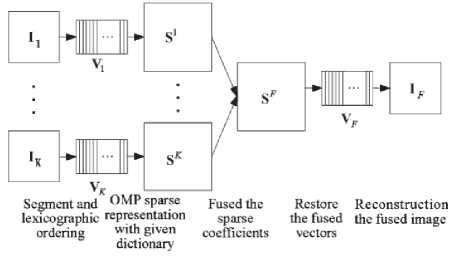
Fig.4. Proposed SR-based fusion method.
-
V. Image Denoising
Images are subject to noise which are captured and transferred from one destination to another. Noise can greatly affect the fusion result. So to make the fusion more effective this paper introduces thresholding to the respective coefficient values after taking the MST decomposition. We consider BayesShrink threshold which performs better than SureShrink in literature in terms of mean square error (MSE).
The BayesShrink threshold is given by [14]:
Wi) = | (8)
an = median (|Detaifs|)/0.6745 (9)
The noise model of image x is considered as x = I + n and source image (I) and source noise (n) are assumed to be independent. Therefore the average noise (variance) and signal power can be calculated as,
0 2 = o i + о П (10)
where о 2 is the variance of the observed signal о , is the noise density for source image. The output noise power of source image ст2 is
O i
Jmax((os2 - O? 2 ),0)
-
VI. Proposed Method
The proposed image fusion methodology contains the following five steps which are described below:
-
A. MST Decomposition: Apply MST on the two source images {IA, IB} to obtain their low-pass bands {LA, LB} and high -pass bands {HA, HB}.
-
B. Thresholding: Perform thresholding as obtained from Equation (7) on the low-pass and high-pass to remove the unnecessary coefficients from the decomposintion.
-
C. Low –pass fusion:
-
i. The image I is divided by appling sliding window technique to {IA,IB} into image patches of size Vn X Vn from upper left to lower right with a step length of pixels. We have also considered that there are T patches denoted as {fA}^1 and {P B }^1 in LA and LB respectively.
-
ii. Rearrange {P A , P B } into column vectors and also rearrange {V A , V B } for each iteration by
VA = vA - VA. i
VB = vB - vB. 1
where 1 denotes one dimensional vector asn X 1 and V A and V B are average values of all elements in p and V B respectively.
-
iii. The sparse coefficients vectors {« A , « B } of {V ,V B }is calculated using OMP algorithm [13] by
«A = argmin H«H0 st ||VA - D«|2 < e «B = argmin H«H0 st |VB - Da|2 < e
Where D is the learned dictionary and e is tolerance of sparse value.
-
iv. Merge « A and « B with max-L1 rule to obtained the fused sparse vectors
« F = {
V
«A if ll«AH1 > ||«ВН1
«в other-wise
The fused result of V X and V b is calculated by
VX=D«F + Vf1
Where the merged mean value Vf is obtained by V = { V if «F = «B
( Vb otherwise
The above iterative procedures for all the source image patch in {PA}^ and {РД}^ to obtained all the fused vectors
{p F } ;=i and{V F } ;=i .
vi. At the final steps the low-pass fused results denoted LF . For each V F reshape it into a patch P F and then plug P F into its original position in Lf . As patches are overlapped, each pixel’s value in LF is averaged over its accumulation times.
-
D. High-pass fusion: Apply threshold rule using Equation (7) for filter to ensure fused image contains source image. And then merge HA and Hb to obtained HF with the popular ‘max-absolute’ rule each
coefficients of image A and B.
-
E. MST reconstruction: Perform the corresponsing
inverse MST over LF and HF to reconstruct the final fused image IF.
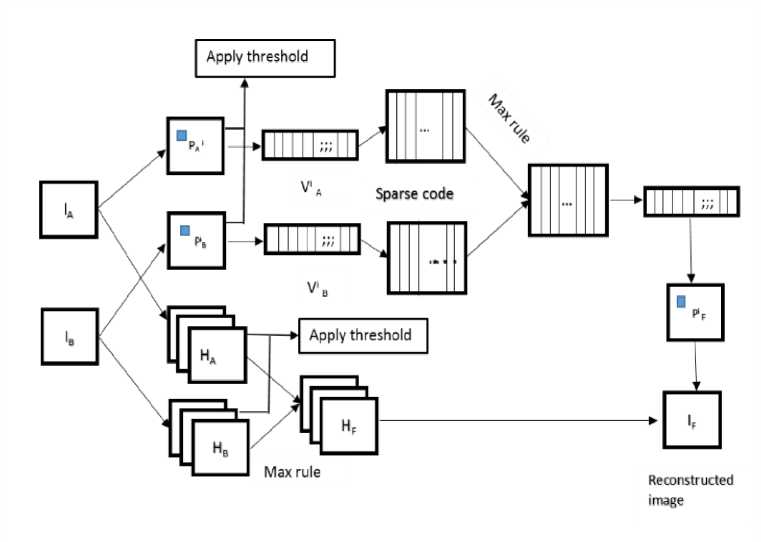
Fig.5. Block diagram of proposed method.
-
VII. Experiments and Analysis
The source image pairs are taken from database [15 as shown in Figure 6,] and grouped of these images to apply proposed ST-SR method for image fusion and compare the results with other MST methods.
For dictionary process in image sparse presentation, we assign randomly values in dictionary D of size 64 X 256 from the image patches of training dataset image then sparse coding is done to get the sparse matrix of signal then K-SVD algorithm [11] has been run to update the dictionary. In simulation, we have estimated 100,000 of training data and 8x8 patches, and these patches are randomly sampled into image. In simulation, the dictionary size was set to 256 and the iteration number of K-SVD is fixed to 180.
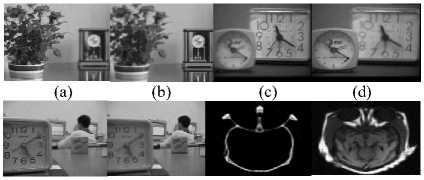
(e)
(f) (g) (h)
Fig.6. Source images pair for experimental analysis[14].
For comparative studies, we have used different MST method and SR such as discrete wavelet transform with sparse representation (DWT-SR), dual-tree complex wavelet transform(DTCWT) and sparse representation (DTCWT-SR), curvelet transform and sparse representation (CT-SR), nonsubsampled contourlet transform (NSCT ) and sparse representation (NSCT-SR), non-subsampled shearlet transform (NSST) with sparse representation (NSST-SR).
Table 1. Performance mesurements of different image fusion method.
|
Methods |
Fig.4 (a)(b) |
Fig.4 (c)(d) |
Fig.4 (e)(f) |
Fig.4 (g)(h) |
|
|
SD |
DWT-SR |
52.2803 |
51.1927 |
47.2138 |
51.7858 |
|
DTCWT-SR |
51.8128 |
50.8592 |
46.9703 |
53.5718 |
|
|
CT-SR |
51.9511 |
50.8515 |
46.8730 |
54.4996 |
|
|
NSCT-SR |
52.1892 |
51.1708 |
47.2209 |
56.8796 |
|
|
NSST-SR |
52.9218 |
51.9778 |
47.9486 |
56.9551 |
|
|
MI |
DWT-SR |
6.4716 |
6.9422 |
7.0805 |
2.2327 |
|
DTCWT-SR |
6.9836 |
7.0816 |
7.4136 |
2.0315 |
|
|
CT-SR |
6.6547 |
7.0543 |
6.9303 |
1.9097 |
|
|
NSCT-SR |
6.9077 |
7.6748 |
7.5160 |
3.0118 |
|
|
NSST-SR |
6.9857 |
7.9168 |
7.9504 |
3.1877 |
|
|
EN |
DWT-SR |
7.4870 |
7.3228 |
7.1110 |
6.1926 |
|
DTCWT-SR |
7.4448 |
7.3318 |
7.0817 |
6.7317 |
|
|
CT-SR |
7.4642 |
7.3946 |
7.0999 |
6.8621 |
|
|
NSCT-SR |
7.4608 |
7.3292 |
7.0962 |
6.5892 |
|
|
NSST-SR |
7.6676 |
7.5513 |
7.4051 |
6.9054 |
|
|
SSIM |
DWT-SR |
0.8810 |
0.8907 |
0.9022 |
0.5449 |
|
DTCWT-SR |
0.8865 |
0.8938 |
0.9078 |
0.7004 |
|
|
CT-SR |
0.8862 |
0.8941 |
0.9070 |
0.6811 |
|
|
NSCT-SR |
0.8918 |
0.9015 |
0.9112 |
0.7637 |
|
|
NSST-SR |
0.8994 |
0.9098 |
0.9195 |
0.7692 |
|
|
AB/F |
DWT-SR |
0.6946 |
0.6810 |
0.7038 |
0.5773 |
|
DTCWT-SR |
0.7166 |
0.7102 |
0.7277 |
0.6334 |
|
|
CT-SR |
0.7023 |
0.6994 |
0.7069 |
0.5898 |
|
|
NSCT-SR |
0.7132 |
0.7216 |
0.7303 |
0.7368 |
|
|
NSST-SR |
0.7195 |
0.7271 |
0.7358 |
0.7394 |
|
|
Q G |
DWT-SR |
0.6874 |
0.6912 |
0.7171 |
0.5645 |
|
DTCWT-SR |
0.7071 |
0.7192 |
0.7368 |
0.6159 |
|
|
CT-SR |
0.6867 |
0.7087 |
0.7192 |
0.5713 |
|
|
NSCT-SR |
0.7025 |
0.7320 |
0.7400 |
0.7329 |
|
|
NSST-SR |
0.7096 |
0.7371 |
0.7473 |
0.7394 |
In this research work, five popular metrics have been used for evaluating the quality of a fused image [16] , which are Standard deviation (SD), Mutual information (MI), Entropy (EN), Standard similarity index metric (SSIM), QAB/F, the gradient based image fusion metric Q G represents in Table I. In Table I shows the proposed method such as NSST-SR is achieved the highest results in bold face mark for SD, MI, EN SSIM, QAB/F,QG than DWT-SR, DTCWT-SR, CT-SR, NSCT-SR. Also the fused image of NSST-SR shows good quality visual fused image in Figure 7 (e) for comparison with them.
Table 2. Performance mesurements with different noise level for f different image fusion method.
|
Sigma(a) |
Methods |
PSNR |
|
10 |
DWT-SR |
31.4988 |
|
DTCWT-SR |
31.9889 |
|
|
CT-SR |
31.8623 |
|
|
NSCT-SR |
31.8978 |
|
|
NSST-SR |
36.2864 |
|
|
20 |
DWT-SR |
29.3442 |
|
DTCWT-SR |
29.6937 |
|
|
CT-SR |
29.5617 |
|
|
NSCT-SR |
29.5967 |
|
|
NSST-SR |
33.8054 |
|
|
30 |
DWT-SR |
28.5474 |
|
DTCWT-SR |
28.7777 |
|
|
CT-SR |
28.7332 |
|
|
NSCT-SR |
28.7283 |
|
|
NSST-SR |
32.7254 |
|
|
40 |
DWT-SR |
28.1573 |
|
DTCWT-SR |
28.3370 |
|
|
CT-SR |
28.3004 |
|
|
NSCT-SR |
28.2909 |
|
|
NSST-SR |
32.1793 |
|
|
50 |
DWT-SR |
27.9320 |
|
DTCWT-SR |
28.0779 |
|
|
CT-SR |
28.0589 |
|
|
NSCT-SR |
28.0208 |
|
|
NSST-SR |
31.7270 |
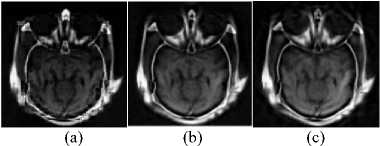
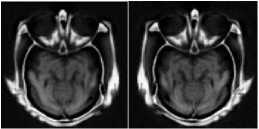
(d) (e)
Fig.7. Fused image of (a) DWT-SR, (b) DTCWT-SR, (c) CT-SR, (d)
NSCT-SR, (e) NSST-SR, for a = 0.
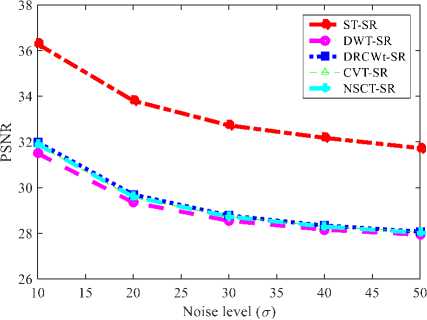
-
VIII. Conclusion
This paper work proposes a method for image fusion using MST and sparse representation. It gives us the result which overcomes the disadvantage introduced in MST and SR method individually. Training time for Dictionary in SR is relatively high. We use a dataset consisting different type of images and which contain about 40 images. For thresholding the image we have used bayesShrik thresholding which take the threshold value in different direction of image under certain transformation domain, which gives good threshold and results in a fused image which is noiseless in great measure. In the future, this model can be enhanced and cope with different efficient transformation domain which can take the geometry of image in better way. So it will be interesting to see how advancement is made in this approach.
Список литературы Simultaneous Image Fusion and Denoising based on Multi-Scale Transform and Sparse Representation
- Z. Zhang and R. S. Blum, "A categorization of multiscale-decomposition-based image fusion schemes with a performance study for a digital camera application," in Proceedings of the IEEE, vol. 87, no. 8, pp. 1315-1326, Aug 1999.
- H. Li, B. S. Manjunath, S. K. Mitra, “Multisensor Image Fusion Using the Wavelet Transform,” Graphical Models and Image Processing, Volume 57, Issue 3, pp. 235-245, 1995.
- V. S. Petrovic and C. S. Xydeas, “Gradient-based multiresolution image fusion,” IEEE Transaction Image Processing., Volume. 13, No. 2, pp. 228–237, Feb. 2004.
- J. J. Lewis, J. Robert, O’Callaghan, S. G. Nikolov, D. R. Bull, Nishan Canagarajah, “Pixel- and region-based image fusion with complex wavelets,”Information Fusion, Volume 8, Issue 2, , pp. 119-130, April 2007
- F. Nencini, A. Garzelli, S. Baronti, L. Alparone, “Remote sensing image fusion using the curvelet transform,”Information Fusion, Volume 8, Issue 2, pp. 143-156, April 2007.
- Villegas, O.O.V., De Jesus Ochoa Dominguez, H., Sanche, V.G.C., “A Comparison of the Bandelet, Wavelet and Contourlet Transforms for Image Denoising,” Seventh Mexican International Conference on Artificial Intelligence, MICAI 2008, pp. 207–212, 2008.
- M. N. Do and M. Vetterli, "The contourlet transform: an efficient directional multiresolution image representation," in IEEE Transactions on Image Processing, vol. 14, no. 12, pp. 2091-2106, Dec. 2005.
- W. Q. Lim, "The Discrete Shearlet Transform: A New Directional Transform and Compactly Supported Shearlet Frames," IEEETransactions on Image Processing, Volume. 19, No. 5, pp. 1166-1180, 2010.
- Yu Liu, Shuping Liu, Zengfu Wang, “A general framework for image fusion based on multi-scale transform and sparse representation,”Information Fusion, Volume 24, July 2015, pp. 147-164,
- A. Agarwal, A. Anandkumar, P. Jain, P. Netrapalli, R. Tandon “Learning Sparsely Used Overcomplete Dictionaries.” JMLR: Workshop and Conference Proceedings, vol 35, pp. 1–15, 2014
- Christopher J Hillar and Friedrich T Sommer. Ramsey theory reveals the conditions when sparsecoding on subsampled data is unique. arXiv preprint arXiv:1106.3616, 2011
- D. A Spielman, H.Wang, and J. Wright, “Exact recovery of sparsely-used dictionaries,” Journal of Machine Learning Research pp.1–35, 2012.
- M. Yaghoobi, T. Blumensath and M. E. Davies, "Dictionary Learning for Sparse Approximations With the Majorization Method," IEEE Transactions on Signal Processing, Volume. 57, No. 6, pp. 2178-2191, 2009.
- B. Yang and S. Li, "Multifocus Image Fusion and Restoration with Sparse Representation," in IEEE Transactions on Instrumentation and Measurement, Volume 59, No. 4, pp. 884-892, 2010
- M. Yaghoobi, T. Blumensath and M. E. Davies, "Dictionary Learning for Sparse Approximations With the Majorization Method," IEEE Transactions on Signal Processing, Volume. 57, No. 6, pp. 2178-2191, 2009.
- B. Yang and S. Li, "Multifocus Image Fusion and Restoration with Sparse Representation," in IEEE Transactions on Instrumentation and Measurement, Volume 59, No. 4, pp. 884-892, 2010.
- M. Aharon, M. Elad, and A. Bruckstein, “K-SVD: an algorithm for designing overcomplete dictionaries for sparse representation," IEEE Transaction Signal Processing, Volume 54, No. 11, pp. 4311-4322, 2006.
- J. Tropp and A. Gilbert, “Signal recovery from random measurements via orthogonal matching pursuit,” IEEE Transactions on Information Theory, Volume 53, No. 12, pp. 4655 – 4666, 2007.
- D. L. Donoho, “De-noising by soft thresholding,” IEEE Transaction Information Theory, vol. 41, no. 3 pp. 613-627, May 1995.
- Image fusion. Some source images (multi-focus, multi-modal) for image fusion: http://home.ustc.edu.cn/~liuyu1/
- P. Jagalingam, Arkal Vittal Hegde, “A Review of Quality Metrics for Fused Image,”Aquatic Procedia, Volume 4, 2015, pp. 133-142.

